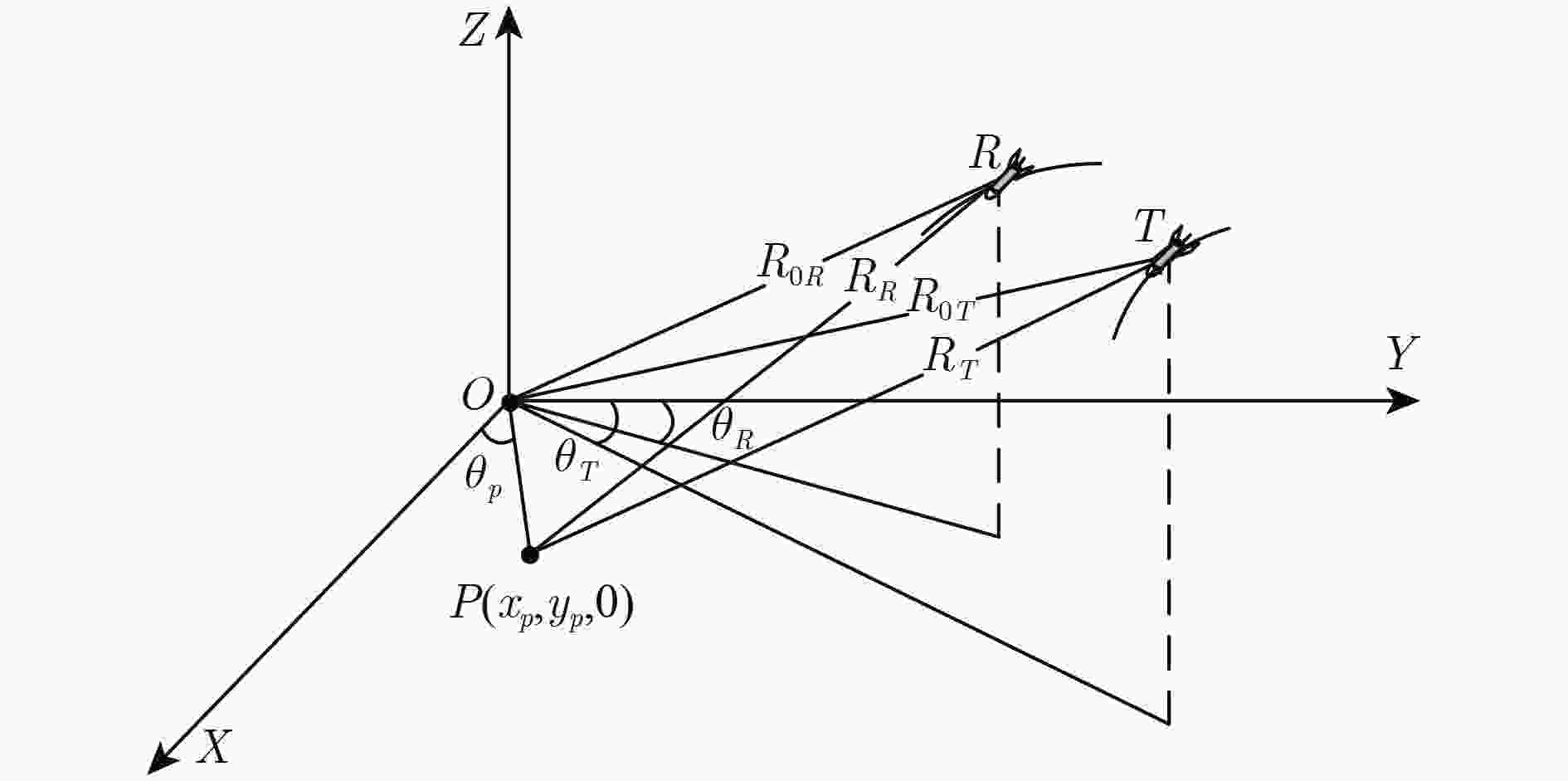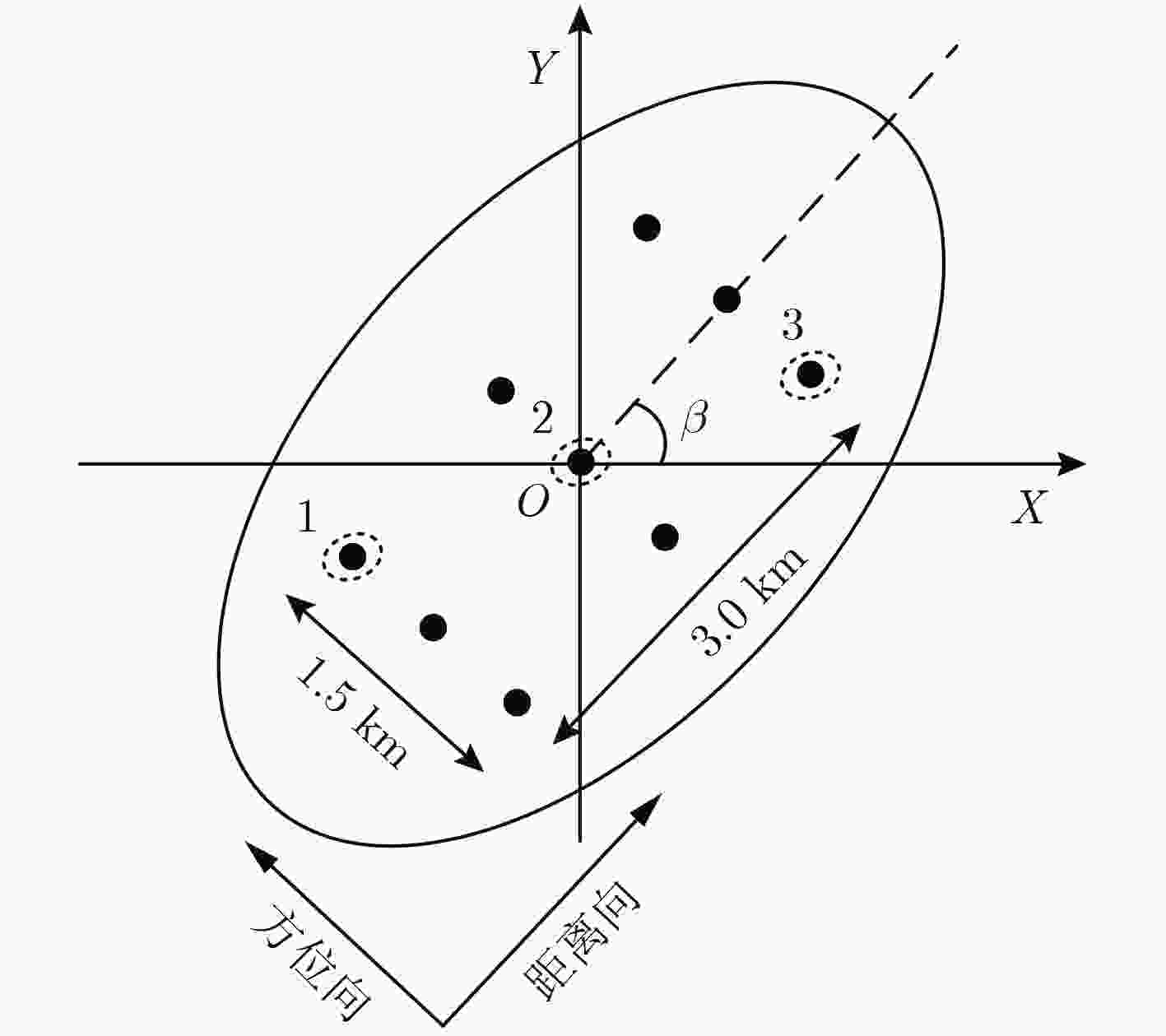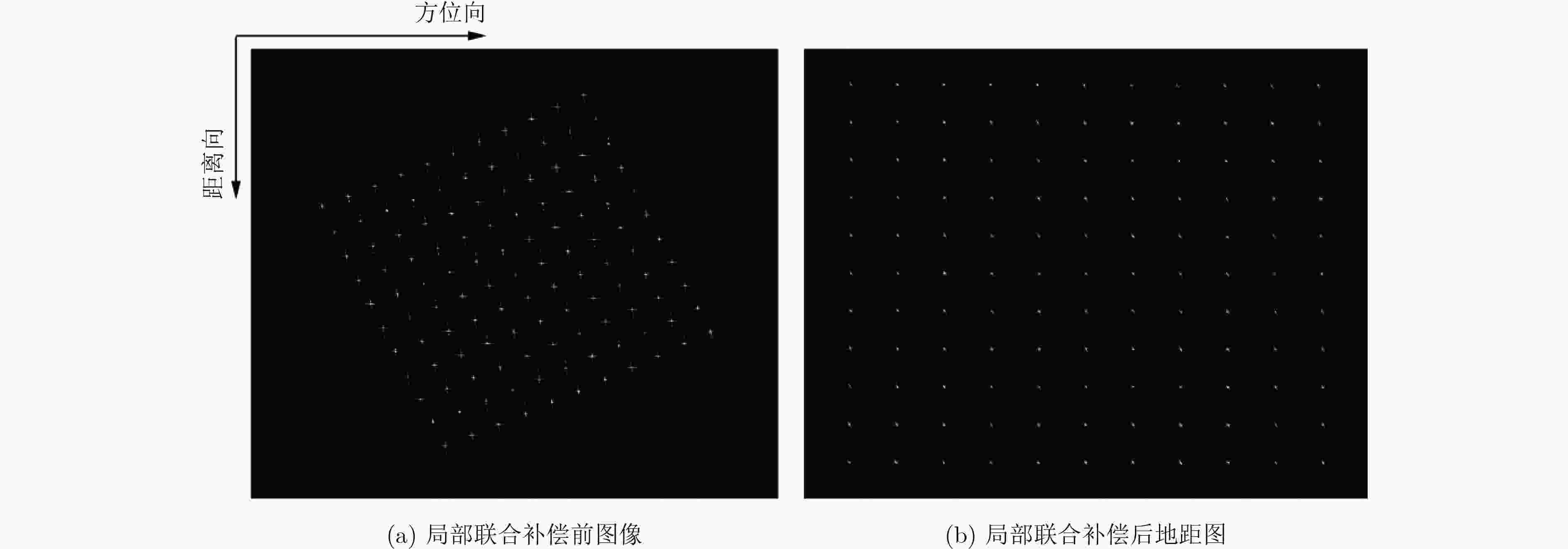New Back-filtering PFA Imaging Algorithm and Distortion Correction Method for Missile-borne Bistatic SAR with Curved Track
-
摘要: 在弹载曲线轨迹双基SAR成像中,三轴速度与加速度降低了传统的双基等效斜距模型精度,也使得基于匀速直线平飞轨迹模型的极坐标格式算法(PFA)不再适用。受双平台加速度引入的空变运动误差影响,传统的分子块补偿方法会造成图像子块间地物景象不连续问题,影响后续的图像匹配应用。针对这些问题,该文提出一种新的双基SAR成像算法——反向滤波PFA算法(BFPFA),该算法是基于改进的通用化双基等效斜距模型(IGBERM),利用PFA插值将频谱投影到地距平面,通过构建空变相位误差与图像畸变联合补偿滤波器,并采用反向映射插值,实现在斜地转换过程中对运动误差、波前弯曲与图像畸变进行局部联合补偿,获得的无畸变双基SAR地距图更有利于后续的图像匹配应用。最后,仿真实验验证了所提算法的有效性。Abstract: The traditional bistatic equivalent range model has low accuracy and make the traditional Polar Format Algorithm (PFA) are inapplicable in missile-borne bistatic Synthetic Aperture Radar (SAR) imaging with curved track due to the existing of three-axis velocity and acceleration. In addition, due to the existing of space-variant motion error introduced by acceleration, the traditional 2-D sub-block compensation method will cause the discontinuities between the image sub-blocks, thus affecting the subsequent image matching application. In view of these problems, this paper proposes a Back-Filtering PFA algorithm (BFPFA) which is based on the Improved Generalized Bistatic Equivalent Range Model (IGBERM). Constructing the combined compensating filter of space-variant phase error and geometric distortion, as well as reverse mapping interpolation, can realize the combined compensation of motion error, wavefront bending and geometric distortion in the process of oblique conversion, and obtain the SAR distance map without distortion, which is more conducive to the subsequent image matching applications. Finally, the simulations validate the effectiveness of the proposed algorithm.
-
表 1 成像仿真参数
载频(GHz) 17 距离带宽(MHz) 200 脉冲重复频率(kHz) 10 采样率(MHz) 250 接收机坐标(km) (4.47, 11.94, 22.08) 发射机位置(km) (6.64, 11.28, 23.62) 接收机速度(m/s) (1100, –680, –346) 发射机速度(m/s) (1000, –450, –294) 接收机加速度(m/s2) (15, 25, –10) 发射机加速度(m/s2) (15, –35, –20) -
PU Wei, LI Wenchao, and LÜ Youxin, et al. An extended omega-K algorithm with integrated motion compensation for bistatic forward-looking SAR[C]. IEEE Radar Conference, Arlington, USA, 2015: 1291–1295. 孟自强, 李亚超, 邢孟道, 等. 基于斜距等效的弹载双基前视SAR相位空变校正方法[J]. 电子与信息学报, 2016, 38(3): 613–621 doi: 10.11999/JEIT150782MENG Ziqiang, LI Yachao, XING Mengdao, et al. Phase space-variance correction method for missile-borne bistatic forward-looking SAR based on equivalent range equation[J]. Journal of Electronics&Information Technology, 2016, 38(3): 613–621 doi: 10.11999/JEIT150782 LI Zhenyu, XING Mengdao, LIANG Yi, et al. A frequency-domain imaging algorithm for highly squinted SAR mounted on maneuvering platforms with nonlinear trajectory[J]. IEEE Transactions on Geoscience&Remote Sensing, 2016, 54(7): 4023–4038 doi: 10.1109/TGRS.2016.2535391 ZHANG Lei, QIAO Zhijun, XING Mengdao, et al. A robust motion compensation approach for UAV SAR imagery[J]. IEEE Transactions on Geoscience&Remote Sensing, 2012, 50(8): 3202–3218 doi: 10.1109/TGRS.2011.2180392 ZENG Letian, LIANG Yi, XING Mengdao, et al. A novel motion compensation approach for airborne spotlight SAR of high-resolution and high-squint mode[J]. IEEE Geoscience&Remote Sensing Letters, 2016, 13(3): 429–433 doi: 10.1109/LGRS.2016.2517099 丁金闪, OTMAR L, HOLGER N, 等. 双基SAR成像的点目标解析频谱研究[J]. 电子与信息学报, 2009, 31(4): 763–767DING Jinshan, OTMAR L, HOLGER N, et al. Study of point target spectrum for bistatic SAR imaging[J]. Journal of Electronics&Information Technology, 2009, 31(4): 763–767 孟自强, 李亚超, 邢孟道, 等. 弹载双基前视SAR扩展场景成像算法设计[J]. 西安电子科技大学学报(自然科学版), 2016, 43(3): 31–37 doi: 10.3969/j.issn.1001-2400.2016.03.006MENG Ziqiang, LI Yachao , XING Mengdao, et al. Imaging method for the extended scene of missile-borne bistatic forward-looking SAR[J]. Journal of Xidian University, 2016, 43(3): 31–37 doi: 10.3969/j.issn.1001-2400.2016.03.006 CHEN Si, YUAN Yue, ZHANG Shuning, et al. A new imaging algorithm for forward-looking missile-borne bistatic SAR[J]. IEEE Journal of Selected Topics in Applied Earth Observations&Remote Sensing, 2016, 9(4): 1543–1552 doi: 10.1109/JSTARS.2015.2507260 ZENG Hongcheng, WANG Pengbo, CHEN Jie, et al. A novel general imaging formation algorithm for GNSS-based bistatic SAR[J]. Sensors, 2016, 16(3): 294–308 doi: 10.3390/s16030294 LI Dong, WANG Wei, LIU Hongqing, et al. Focusing highly squinted azimuth variant bistatic SAR[J]. IEEE Transactions on Aerospace and Electronic Systems, 2017, 52(6): 2715–2730 doi: 10.1109/TAES.2016.150491 LI Yanping, ZHANG Zhenhua, XING Mengdao, et al. Bistatic spotlight SAR processing using the frequency-scaling algorithm[J]. IEEE Geoscience&Remote Sensing Letters, 2008, 5(1): 48–52 doi: 10.1109/LGRS.2007.907306 WANG R, LOFFELD O, NIES H, et al. Focusing spaceborne/airborne hybrid bistatic SAR data using wavenumber-domain algorithm[J]. IEEE Transactions on Geoscience&Remote Sensing, 2009, 47(7): 2275–2283 doi: 10.1109/TGRS.2008.2010852 LIU Baochang, WANG Tong, WU Qisong, et al. Bistatic SAR data focusing using an omega-K algorithm based on method of series reversion[J]. IEEE Transactions on Geoscience&Remote Sensing, 2009, 47(8): 2899–2912 doi: 10.1109/TGRS.2009.2017522 RIGLING B D and MOSES R L. Polar format algorithm for bistatic SAR[J]. IEEE Transactions on Aerospace Electronic Systems, 2004, 40(4): 1147–1159 doi: 10.1109/TAES.2004.1386870 WANG Xin, ZHU Daiyin, MAO Xinhua, et al. Space-variant filtering for wavefront curvature correction in polar formatted bistatic SAR image[J]. IEEE Transactions on Aerospace and Electronic Systems, 2012, 48(2): 940–950 doi: 10.1109/TAES.2012.6178040 唐世阳. 曲线运动轨迹SAR成像方法研究[D]. [博士论文], 西安电子科技大学, 2016: 93–120.TANG Shiyang. Study on imaging methods for SAR on curved-path platforms[D]. [Ph.D. dissertation], Xidian University, 2016: 93–120. -






 下载:
下载:









 下载:
下载:
